It’s that time of year again. The time when we look back and pick out our favourites of everything and anything that happened during the year. Most people do their “top whatever” lists in early December, but I like to hold off until the first week of January so as not to miss anything that might just squeak by. Oh, and my list is one of video games. Just in case.
There are a few rules that certainly have big effects on my list. First and foremost, I don’t include any re-releases, no matter how much of an update they’ve gotten. Also, it is comprised only of games I’ve played. It would be kind of ruin the integrity of the list if I just threw any old game on it. The little problem with this is that I didn’t play a whole lot of games this year. Sure, compared to some people, I may have played a lot, but there wasn’t a whole lot of variety. I probably only rented like five or six games total this year. But oh well. That’s what you get.
That’s pretty much the whole intro. What else is there really to say? I’m gonna be doing enough reflection in the bajillion words below, so I don’t really need any of that here. So yeah. Go.
~ #11 (honourable mention) ~
Trauma Center: Under The Knife

Let me start by explaining the honourable mention. See, I haven’t really played Trauma Center. I have played the demo version, which was in Japanese, but I haven’t played the whole game. And since I haven’t actually played the whole game, I can’t in good faith give it a real spot on the list. But rest assured that if had, it would totally be there. What I did play of Trauma Center was really cool, and somewhat challenging as well. The game has topped my “most wanted” list since long before it came out, but alas, I’ve yet to find it anywhere. The local Electronics Boutiques have both informed me that they won’t be getting any more, and if EB isn’t getting any more, nuts to all the other stores. The only hope I have left is… eBay? Maybe I’m gonna have to investigate the Microplay scene. If anyone ever sees it, there’s a very generous bounty to be claimed… *hint hint*
EDIT: By the time this was posted, I got the game. As expected, it r0x0rz my b0x0rz.
~ #10 ~
Lost in Blue

Lost is Blue is lucky. Lucky that I haven’t gotten my hands on a copy of Trauma Center. It’s also lucky that Metal Gear Solid 3 was just a little too complicated and silly for my tastes. Actually, there are a lot of games I considered for this position, but Lost in Blue is just so neat that I couldn’t deny it.
A sequel to the underappreciated Survival Kids for the Game Boy Colour, Lost in Blue is a sim of a different persuasion. The idea of the game is that you’re stranded on an island with a girl, and you have to survive and find a way off the island. Or just survive. You don’t have to escape if you don’t want to. There are plenty of thins to do on the island, like rummage for food, collect stuff, make that stuff into tools, build furniture, hunt animals, explore, and more. The island provides a ton of stuff to do, and it’s up to you when you want to do it and if you even want to do it at all. the only thing you have to do (if you don’t want to lose) is to keep yourself and the girl alive. Otherwise, it’s all up to you. You’re even provided with the chance to play through as the girl once you complete the game, which offers an entirely different way to play the game.
Such open-ended gameplay usually has one of two effects on people: it either sucks you in completely, or you get bored right away. The only big difference between this and similar games like The Sims or Animal Crossing is that in Lost in Blue you do actually have an objective, so there is something compelling you to move forward. Not to mention that there are like a jillion different endings, based on your actions and relationship with the opposite character. The only real complaint I have to lodge against the game is that animals only appear in one area, and it takes a lot to get up there. Plus, hunting is really hard/requires luck more than anything.
~ #9 ~
Castlevania: Dawn of Sorrow
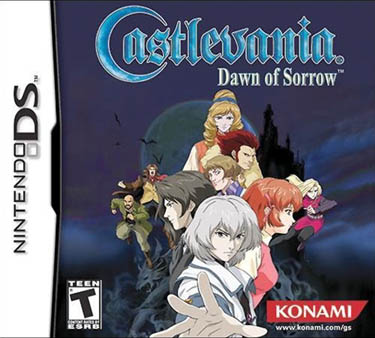
This is the game I’d been waiting for since the DS was released. Aria of Sorrow is my favourite GBA game, and things could only get better with a sequel, right? Right. While it seems kind of harsh to give Dawn of Sorrow 9th place, it’s not so bad on the grand scale. 9th best of all the games I’ve played this year? Not too bad at all.
Castelvania: Dawn of Sorrow is the continued adventure of Soma Cruz, a regular-type guy who just happened to inherit Dracula’s powers by some cruel twist of fate. In Aria of Sorrow, he had to escape Dracula’s castle and keep from being corrupted by his powers. This time around, he’s in pretty deep, as some crazy cult is out to get him and his powers. The story is of the least importance, however, as the game itself is a testament to what beauty can be created on the DS. The game plays out in two dimensions, but every now and then there’s a 3D background that will just blow you away. The touch screen itself is used rather sparsely, but the fact that there are two screens is the single best improvement in a Castelvania game ever. See, the top screen can be used as a map screen, and that in itself is one capital reason to champion the DS. In any game with a map, especially Castelvania, it’s always a hassle to stop to check the map every few steps/rooms, and Dawn of Sorrow eliminates this issue completely by having the map ready for you at all times.
Even without the pretty graphics and cool features, the gameplay itself is more than noteworthy. Like its predecessor, Dawn of Sorrow uses a system of powerups fueled by the souls of your enemies. Every monster in the game has a soul which you can extract and use to your advantage. Some are simple abilities, like gaining throwing knives or summoning familiars, but others so some really cool stuff like letting you do a super jump or regenerating life. The game is pretty balanced, giving you a challenge while never being overly frustrating. Some bosses might drive you nuts, but a couple level-ups or the right soul combination could remedy the problem easily. There are a few different endings, a lackluster “enemy set” mode that you can challenge your friends to, and a handful of unlockables. Those unlockables include a sound test, a boss rush mode, hard mode, and a special mode that’s almost an entirely different game.
~ #8 ~
The Incredible Hulk: Ultimate Destruction

While I’d love to go on and on about this one, it seems I already have. I’d give you a link straight to it, but I’m feeling far too lazy at the moment to figure out the URL and all that shit you need to go through to make a link. So I’ll just type some stuff about the game instead.
Ultimate Destruction is more or less my dream free-roaming game. Of course, my overall dream game would contain many elements of UD, but it would be entirely different, and most likely 2D. Anyway, why do I love this game so much? For one, it’s all about destroying shit. There’s no stealth, no items, no rules. Just pure, unadulterated smashing. The game is basically split up into three categories (all rolled into one, but you won’t be doing one at the same time as another): free-roaming, missions, and sub-missions. The free-roaming is pretty obvious. You traipse around town as the Hulk, breaking whatever you see fit, jumping erratically, and basically just having a great time. The world is your oyster, and you may smash it as you please. Sadly, most of the buildings in the game are indestructible, but it’s still plenty of fun to destroy what can be destroyed. Heck, even my dad was impressed my this game, and the only interaction he has with any video game besides Pitfall is making fun of them.
The missions are pretty straight-forward as well. You’re usually either out to catch or destroy something, sometimes both. Pretty much any mission that strays from that formula has you high-tailing a piece of technology back to your church base. While these missions may not be geared toward destruction, they’re usually rather tricky, and that can provide much fun and frustration. Sub-missions are usually normal things like “race to here so fast” or “save pedestrians from the burning building”. Some however, are completely off-the-wall and have you batting soldiers falling from a helicopter or playing golf with an oil pump and a huge ball of steel. You’re ranked on the sub-missions, and getting gold on the better part of them is really friggin’ hard.
I think the thing that really ties the game together and takes it from good to great, is the freedom is gives you. You’ve all played on iteration of GTA or another, and I can’t help but feel that all of these games feel stuffy and that the controls don’t really flow. Hulk, however, has a very natural feel to it, and once you get down the controls, it’s a very nice feeling you get when you realize you didn’t even have to thing about that insanely complex string of jumps or beatdowns you just launched. It has the same feeling of freedom that Super Mario 64 had, where you feel almost completely unrestrained, allowed to do whatever you please. That’s precisely the reason why Super Mario 64 is my favourite game of all-time, and that’s why I treasure Hulk: Ultimate Destruction as much as I do.
~ #7 ~
Mario & Luigi: Partners in Time
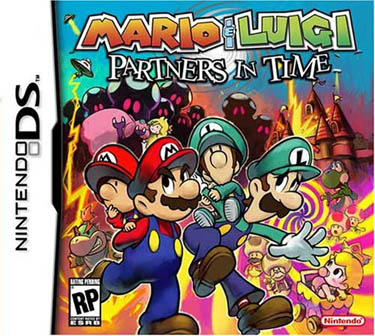
I made fun of Metal Gear Solid 3 a few paragraphs back for being silly, so why on earth does Mario & Luigi: Partners in Time rank so highly on my list? Simple: Mario & Luigi is based around silliness. The first game, Superstar Saga, set a good rhythm of intuitive gameplay and hilarious dialogue, and Partners in Time is in perfect step with it’s older brother.
The best part of the Mario & Luigi series thus far is the story aspect. And I’m not just talking about plot here. The dialogue is written with more than a pinch of humour, the characters are all extremely lively and often outrageous, and yeah, even the plot is pretty good. While in most RPGs, you’ll spend a lot of time fooling around and making sure you don’t miss anything, in Partners in Time you’ll be heading pretty much straightforward the whole time. Yes, you might go back to play some mini-games over or level a bit (it’s not that necessary), but most of the time you’ll just be moving forward. While it’s somewhat due to the fact that you’ll always want to see what’s going to happen next, I have to admit that the game is pretty linear. There are no sidequests to speak of, which is sad, and no bonuses after you beat the final boss, but chances are that you’ll be having so much fun you won’t miss those things.
The gameplay itself is unique to the series (and in a way, to the entire line of Mario RPGs), in that battles take both real-time and turn-based elements. In this game, you have play not only as Mario and Luigi, but the baby-sized bros as well. This situation has you playing as four characters at once, with each bro assigned to his own face button. Luckily, the only time you have to use all four buttons in tandem in four-bro battles, and this can lead to some hairy situations if you haven’t memorized your buttons. A lot of the time, the pairs will split up and do their own thing, and then you only have to look after two bros at once. Action commands liven up the battles, helping you max out your damage potential and avoid enemy attacks entirely, sometimes ever scoring a counterattack. While the action commands in the Paper Mario games would only serve to ease battles a little bit, in the Mario & Luigi games, if you’re really good, you could probably finish the game without getting hit once.
All in all, the game is as good or slightly better than the first. While the battling can sometimes get overly complex, it’s always fun and keeps you interested and involved, unlike traditional RPGS. If you want some more details, go check out the (very) short review in the 2005 Christmas article.
~ #6 ~
We <3 Katamari
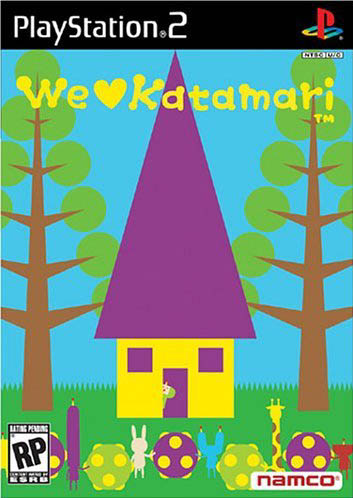
What? What’s not fun about rolling a ball? Balls are like the first things we play with as babies, and even as we grow up, they still play a big roll (punny!) in our lives (at least for those of us who aren’t afraid of sports). So why not make a game that’s key feature is that you get to roll around a ball? Namco took up the challenge, and after the super-niche hit Katamari Damacy took the world by storm, what else could they do but appease the fans and roll out the Katamari for another go?
Katamari Damacy was the main reason I purchased my PS2. Yeah. That’s right, I got it mostly for a single game. A game I hadn’t even played at the time. Call me what you will, but it was money well spent. For hours I rolled around that katamari, and never yearned for more. The game didn’t offer a ton of gameplay outside rolling up as much crap as you could, but it was good enough. Like how people could play Space Invaders or Pac-Man obsessively. But Namco decided that we were worth it, and they put their best minds to the test and released We <3 Katamari sometime in mid-2005. What I got, I never would have expected. The game had been expanded with so many new stages, challenges, features, objects, and playable characters. They even managed to build in a cooperative mode that puts two people at the reins of a single Katamari.
The object of the game is to appeal to the fans of the King of All Cosmos, and roll around your Katamari. No big difference, right? Well this time, it’s not just a challenge to get your Katamari as big as you can within a time limit. No, there are stages that have you collect so many objects, roll a Katamari as fast as you can, keep a fire burning, and even one stage where you have to build a snowman. The wealth of new challenges is very pleasing, and it only gets better. In the first game, you could roll up presents for your character to wear, and cousins to be used in Battle mode. This time, there are a ton more of each, and the various characters can be used in single player as well (though they make no more than an aesthetic difference). Even the “select meadow”, the game’s hub of sorts, is fun to play around in. The only part that drags the game down is that Namco didn’t include any “eternal” stages, so you’re always working on a time limit. While I do miss them, it’s safe to say the game is of no lesser value because they’re gone.
What else do I need to say to get you to play this game? Do I need to tell you that it’ll fellate you as you play? Because I’m ready to tell you whatever you need to hear. If there’s one game you need to play on this list, it’s We <3 Katamari. The quirky graphics, abundant humour, and stellar yet simple gameplay are more than a match for you, so I want you to give this one a shot. I can’t guarantee you’ll love it like I do, but the odds of having fun are stacked heavily in your favour.
~ #5 ~
MegaMan Zero 4
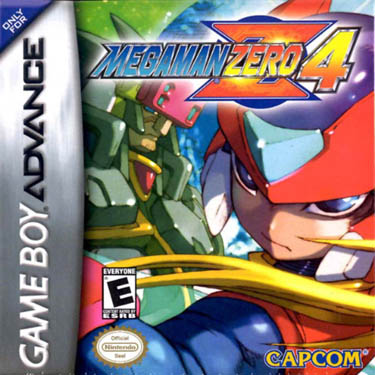
I’m probably going to include the newest MegaMan Zero game somewhere on every future list like this, as long as they keep up the excellent trend. While MegaMan games usually peak in goodness around the second or third game, the Zero series gets better every time. And in leaps and bounds to boot.
MegaMan Zero had the core gamplay down. It was full of action, and was one of the few games of its day that could give you a real headache. Zero 2 didn’t add many features, but lengthened the game and pumped up the difficulty to near-impossible. Zero 3, which earned a spot on last year’s list, toned down the difficulty to a “gifted-human” level, added a handful of new features and tweaked some old ones to make them more user-friendly. The latest game, aptly titled MegaMan Zero 4, is again tweaking and adding whatever it can. Most notably, the tedium of earning and arranging Cyber-Elves is gone. You now have a single elf which you can level up and customize to give you whatever boost you might need. This game’s new weapon, the Z-Knuckle, lets you rip enemies apart and take their weapons for yourself. Some are offensive, some are devensive. Some have ammo limits, some you can blast away with forever. Some are guns, some fit in more with the club family. All in all, the Z-Knuckle provides you with a huge assortment of options and makes for a great addition to Zero’s personal weapons cache.
The upgrade chip system from the previous game returns, although this time you have to make the chips, not find them. You make these chips by picking of parts from defeated enemies and mashing them together. The only flaw here is that the game provides very few chip recipes, so you’ll have to figure out most of them by trial and error or a trip to GameFAQs. Another new feature is the weather changing system. Each stage can be affected by two types of weather, one is a little rougher and gives the boss an advantage, and the other will likely make your jaunt through the stage a lot easier. Obviously, you’ll need to play with the harder weather to get a good rank, but it also serves as the only way to procure the boss’ EX Skills, which is a lot easier than keeping up an A or S rank. Zero 4 also has its own share of unlockable mini-games, and the requirements for most of them are not nearly as obscenely difficult as those in Zero 3.
Overall, it’s a very satisfying game. There hasn’t been such a well-balanced MegaMan game since MegaMan X, and that one didn’t even have all the cool features that Zero 4 boasts. The downside is that… Hmmm… SPOILERS! (Sort of.) Highlight the text to read! The downside is that the ending really wraps everything up. And I mean really wraps everything up. Most of the events that play out near the end and during the final scenes point towards this being the last of the series, and that’s not cool. Though Capcom has pulled many stuns like this in the past (especially with MegaMan), so I doubt things are as grave as they want you to think.
~ #4 ~
The Legend of Zelda: The Minish Cap
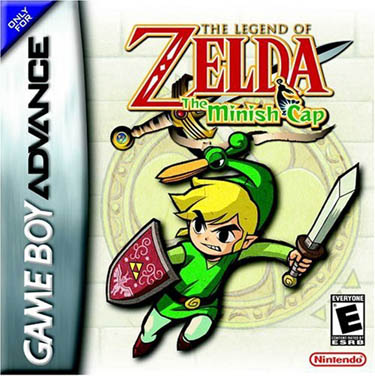
Honestly, I’m gonna come out and say it: This is the best Zelda game since A Link to the Past. It’s not that I didn’t like the games in between, but Ocarina of Time is way overhyped, and Majora’s Mask and The Wind Waker were still missing something. Link’s Awakening was my favourite Zelda game before this (though I think LttP is a better game on the whole. Professional and personal preference are two very different things), I never really got to play the Oracle games, and Four Swords is really in a category of its own. And even if you don’t agree that it’s the best Zelda game, it’s got no competition when you’re asking about the best GBA game ever.
Some people are complaining about the declining number of dungeons in Zelda games. But really, that number was never set in stone. The first game has nine, Link’s Adventure has six, LttP has at least 12, and Link’s Awakening has eight. There are about 11 in OoT, five or six in MM, and the Wind Waker is kind of ambiguous, because some things seem like dungeons, but half the population says no and half says yes. The Minish Cap tops in with five official dungeons, but that’s not really a big deal. The game in itself is huge, with a fully fleshed-out Hyrule to explore, as well as the many little bits that make up the Minish World. There are tons and tons of caves, grottoes, attics, and temples to explore, as well as a smaller world in the sky. The game itself is full of life, overflowing with personality and Zelda charm. Hyrule town is easily the liveliest and most colourful Zelda town ever, and there are characters spread out to even the furthest reaches of the land.
The graphics are a huge part of the game, as they’re unbelievably rich and detailed. Everywhere you go, you’ll be treated to beautiful scenery and extensively animated characters and enemies. The soundtrack is also worthy of note, being of uber-high quality and composed of new tunes and classic themes alike. I swear, this is the first Zelda game since the first to properly utilize the Legend of Zelda theme. The big cave in the graveyard also has a magnificent theme, though to tell the truth, I can’t remember what theme it is. Voices are strewn about pretty liberally, but never manage to get annoying. The difficulty of the game is maybe a bit lacking (it’s no Zelda 2), but it’s certainly not an easy quest to complete.
I’d love to ramble on some more about the Minish Cap, but I already did it once. Go back and check the January 2005 archive page. It’s got an even more long-winded spiel than I’ve put out here, so the inquisitive should definitely check that out. No bones about it, if you have a GBA/DS and you don’t own this game, you’re seriously depriving yourself.
~ #3 ~
Mario Kart DS
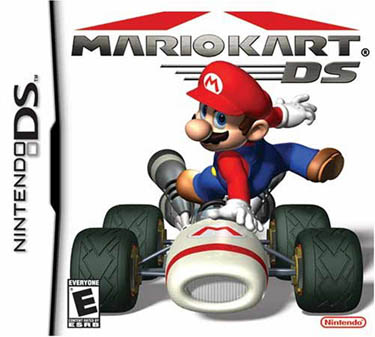
Mario Kart has always been the kart racing game that all the other kart racing games want to be. It’s easy to see why, too. Mario Kart has always had the two essential ingredients for a great game: fun and simplicity. Racing sims are way too hard for those of us who are no so hardcore, and we need something to satiate our needs for speed. Mario Kart does just the trick, as just about anyone can pick it up and get halfway good within a matter of minutes.
While the game itself is excellent, there is only one reason that Mario Kart DS got as high a ranking as it did: the Nintendo Wi-Fi Connection. You may think me a bit pompous when I say that Mario Kart DS is an extremely important game. For a company that went a good five years or so saying that online play is unimportant, Nintendo sure did build some massive hype over the launch of the Nintendo WFC. Not only were people buying into it, but that fact that Mario Kart, a universally loved game, would be the first Nintendo game to enter the good graces of online play. Of course, this went over huge, and the whole world is abuzz with Mario Kart fever. While there are a few limits on what you can do online, it’s still an excellent diversion from trying to find people to play with locally.
But the online play isn’t the only saving grace of Mario Kart DS. No, the single player experience is full of greatness, jam-packed with more features that your tiny little brain could imagine. Most notably is the fact that there are twice as many courses as Mario Kart usually presents. Sure, half of them are taken from the past games in the series (four each), but that still adds up to an amazing amount of racing. There are also missions this time around, some of them strange, some of them mind-bendingly difficult. To top that off, you’ve got actual bosses. That’s right. Diddy Kong Racing tried and failed, but Mario Kart DS has successfully mixed bosses into the kart racing world. Battle mode, while not available online, has been extended to include eight players rather than the normal four. This may not seem like a huge change, but the games are way more frantic when you’ve got eight people launching shells and bananas at once.
For the hard sell, look at it this way: I’m not a fan at all of racing games, but Mario Kart has always been so accessible that even a guy like me can really get into it. I’d say that Mario Kart DS is the DS game to own, but It’d be pretty redundant, as anyone in their right mind who owns a Nintendo DS has this game. Especially now that it comes bundled with the hot red DS.
~ #2 ~
Killer7
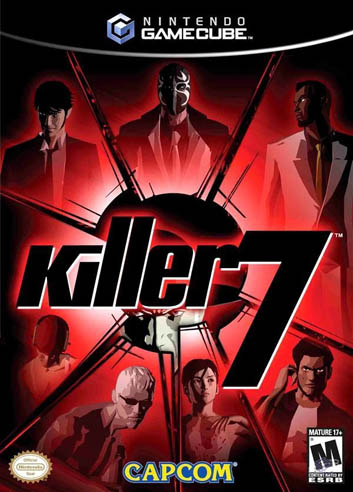
Killer7, how much do I love thee? Let me count the ways.
I made a conscious decision when Killer7 was released that I wouldn’t buy it. To this day, I’ve kept that vow, but not a day goes by that I don’t regret it. I would trade all the half-baked Mario spin-offs and impulse buys in my GC library for this single game. Ever since I returned it to Blockbuster video, I wish I’d bought Killer7. I’m probably the last guy on Earth to know anything about love, but I’m pretty sure that when you think about something every day, there’s something pretty significant there.
Killer7 is easily one of the most off-the-wall games ever created. The story is deeper than the Grand Canyon, and intricate enough to confuse even the rocketingest of scientists. Many little bits of the plot are omitted, and the information they do give you is all out of order, so just understanding the story is challenge enough. Then they add a thick layer of highly stylized graphics on top and flesh it all out with some excellent audio, and you’ve definitely got the whole package. Oh, and did I mention that the gameplay rocks too? Yeah, it does. While the game places you on a rail, and only lets you travel backwards and forwards (and change direction at junctions of course), there is still a huge sense of exploration, as the stages are impressively large and contain a great many paths to travel. The core gameplay is shooting, and the fact that your enemies are naturally invisible just makes it that much more exhilarating. A quick scan will bring them into the visible realm, however, and then it’s just a quick draw competition to see if you can cap their weak points before they get to close and make your head a splode.
Killer7 Really has everything a great game needs. It presents fantastic production values, has a story solid enough to compare to Donny Darko, and is just a blast to play. Not to mention that it’s pretty tough, and gets insane on Hard mode. There are a couple unlockable modes too, if the regular game isn’t enough to quench your thirst for excellent gameplay. But there’s no way you’ll walk away from this one disappointed. If you do, you’re lame. And I really need to go pick this one up.
~ #1 ~
Resident Evil 4
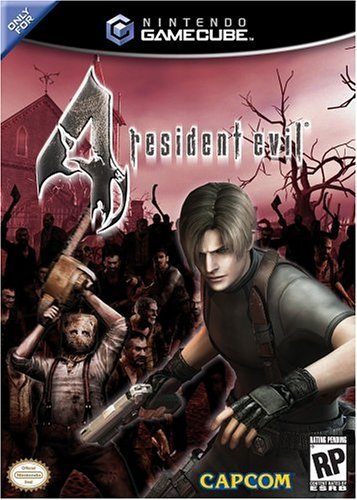
Obvious? Yes. Deserving? Totally. If you didn’t see this one coming a mile away, you need to get your eyes checked. Resident Evil 4 brings so many upgrades to the series that it’s almost an entirely different game. You know what? Scratch that. It is an entirely different game.
The original Resident Evil might have been harder than adamantium, but it was a breath of fresh air for those of use who needed something a little different. Nearly every sequel improved on the formula, with the only exceptions being the Gun Survivor spin-offs (which sucked) and the online games (which I can’t judge, cause I haven’t played either). While other sequels and remakes made small improvements here and there, RE4 takes the idea and completely re-moulds it. Tying in only loosely with older games through a couple characters and some mention of previous events, RE4 literally takes you out of the Resident Evil world. No longer are you fighting for survival against zombies in Raccoon city. Now, you’re thrown into a rural European village, where the locals have been consumed by parasites and are out for blood. The static camera is gone, and now you can aim in more directions than straight, up and down. The inventory system is totally reinvented, letting you carry as many items as you can squeeze into your attache case, rather than having to try to get by with 6-8 item slots. Typewriters are still your saving tool, but item boxes are gone, and you’re no longer forced to find seven billion different keys. Bullets are more plentiful than ever now that enemies drop items, but you’ll still manage to run out now and then.
The game all comes together under what might be the best graphics ever and some seriously spooky tunes, and some top-tier voice work. There are plenty of things to keep you occupied should you become tired of the main game, and of course, there’s a hard mode that will have you ripping your hair out. The game was originally released exclusively for the GameCube, but due to it’s immense success (this game most definitely sold more than a few GameCubes), it’s recently been ported to the PS2. One might expect that on a technologically inferior console, Capcom would have had to make some concessions in the graphics department, but as far as I’ve heard it’s as pretty as ever and doesn’t even suffer from slowdown (like the PS2 Killer7 apparently does). Add on a handful of significant extras, and you’re set to impress.
There’s one thing that I have to get through before I finish. Sadly, the list became out-of-date even before I finished it. See, I had it written out to about number seven, and let it fall to the wayside for a couple weeks before I finished up. In that time, I was able to find and obtain Trauma Center, and I played a couple games that I definitely would have put on the list had it not already been decided, namely Prince of Persia: the Two Thrones and Tony Hawk’s American Wasteland. But alas, the list was intended for games I played in 2005, and those two didn’t come to my attention until 2006. Oh well. Also, it’s really hard to remember all the games I played over the course of the year, so I’m sure there’s at least one deserving title I forgot.
And speaking of deserving titles, some that come immediately to mind include: Jump Superstars (DS), Metal Gear Solid 3 (PS2), Meteos (DS), Kirby Canvas Curse (DS), and shadow of the Colossus (PS2). While many skeptics thought it would die off quickly and made fun of its “small” launch lineup, the DS has had an absolutely mind-blowing year, pumping out all sorts of great games. And with my acquisition of my own PS2, I’ve certainly been exposed to many more games that I would have if I’d stuck it out with only my Nintendos by my side. The more the merrier, you know?
I feel kind of bad that there wasn’t a little more variety on the list, but that’s kind of what you get for playing mostly the same kinds of games, I guess. you’re thinking it, but you should know that I didn’t rate the games on fanboyism alone. No. If that had been the case, there would have been a lot more Ninja Turtles 3: Mutant Nightmare on it. I picked my games based on either how much time I spent with them, and how much I want to play them when I’m doing something else. Heck, on that latter note alone, Killer7 should have taken first, but I’ve gotta be fair. Seriously. I think about Killer7 and how much I love it all the time. I really should have bought it… In any case, I’ll be keeping a list of games that I play in 2006 so that I’ll have an easier time coming up with the ten best when December rolls around.
